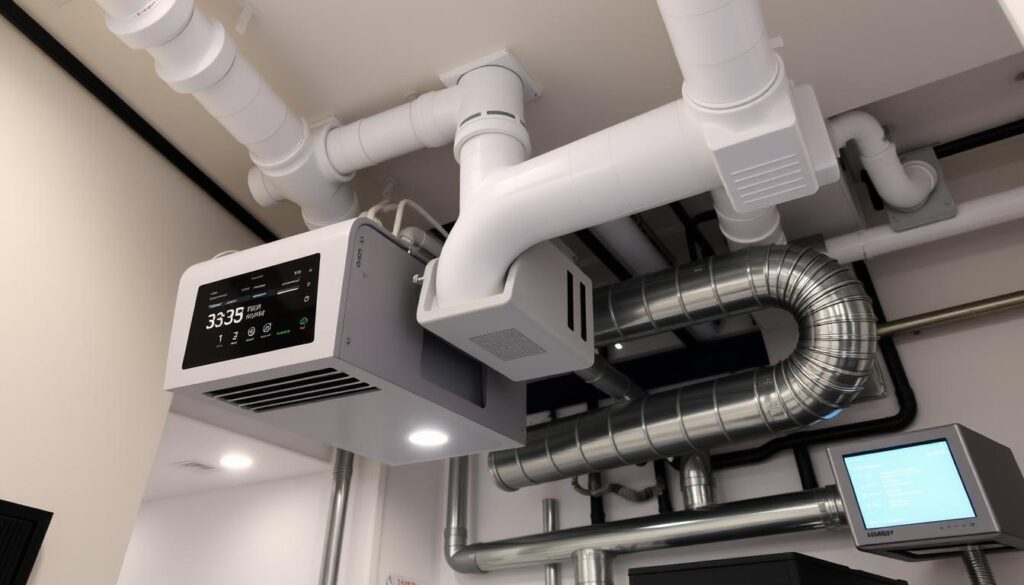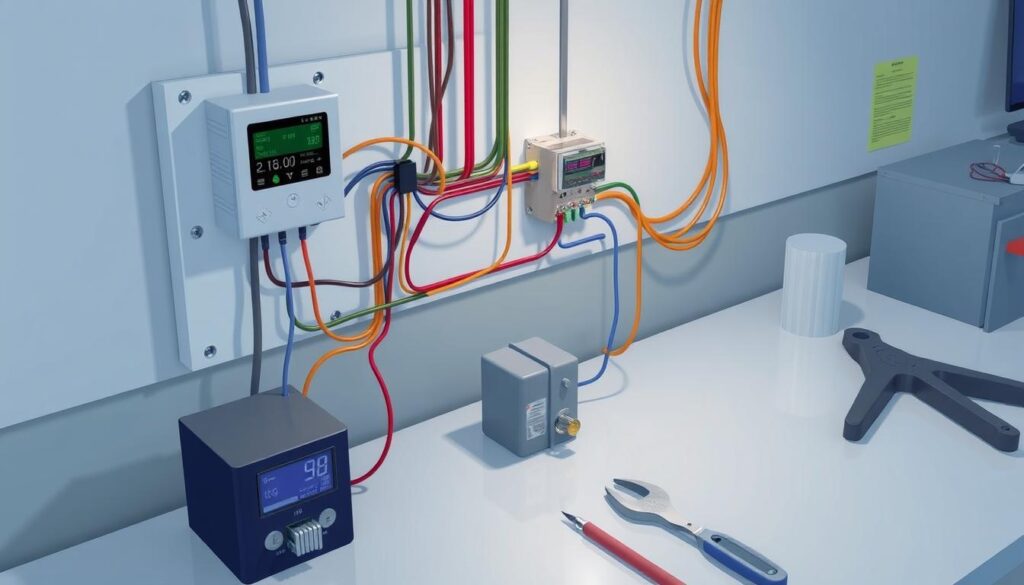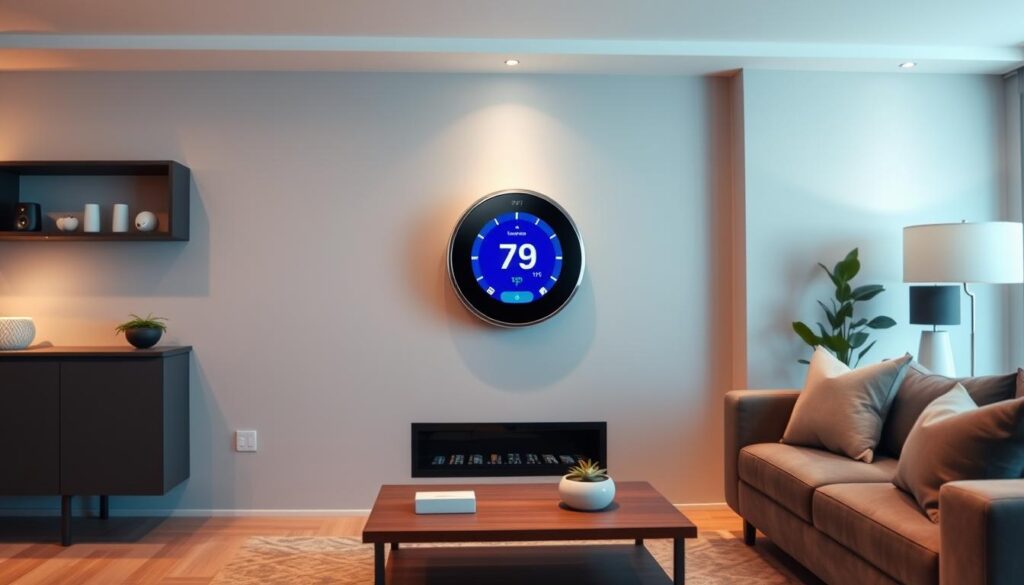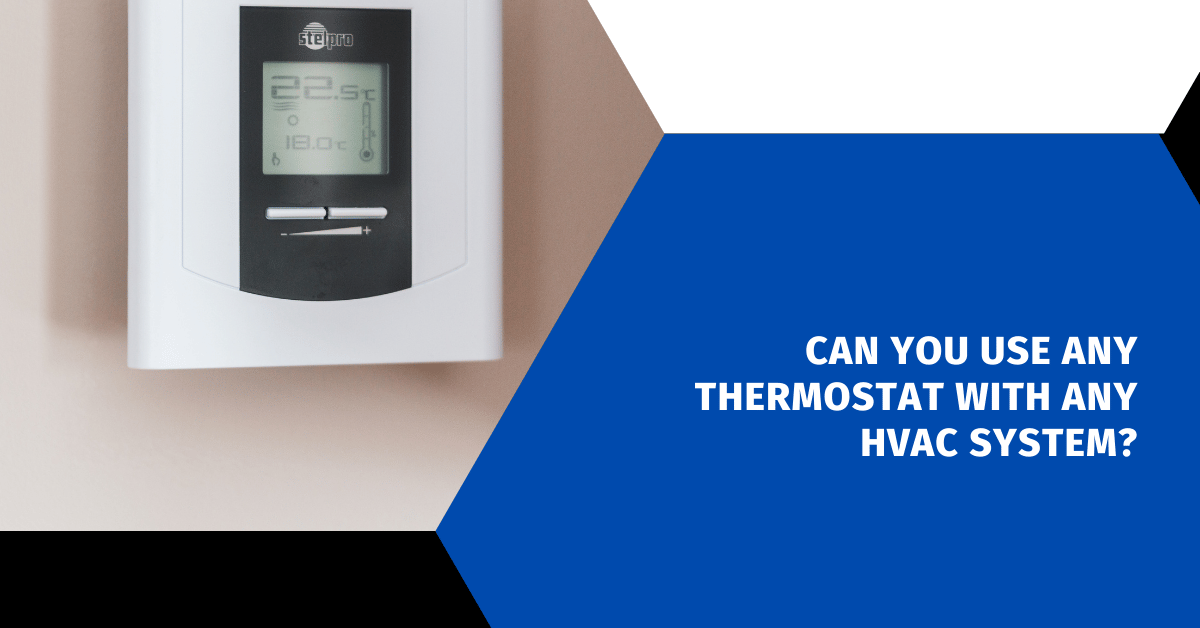Affiliate Disclosure
HVAC Guide Guys is a participant in the Amazon Services LLC Associates Program, an affiliate advertising program designed to provide a means for sites to earn advertising fees by advertising and linking to Amazon.
Can You Use Any Thermostat With Any HVAC System? Did you know 90% of homes in the U.S. use HVAC systems for climate control? But, many don’t know not all thermostats work with every HVAC system. Choosing the wrong thermostat can cause poor performance, higher energy bills, and damage to your HVAC.
When it comes to your home’s climate control, thermostat compatibility is key. We’ll explore HVAC system types, what makes a thermostat compatible, and how to choose the right one for your home.

Key Takeaways
- HVAC systems come in various types, each with specific power and wiring requirements for thermostats.
- Using an incompatible thermostat can lead to performance issues, increased energy consumption, and potential damage to your HVAC system.
- Factors like voltage, number of stages, and the presence of a C-wire must be considered when selecting a compatible thermostat.
- Professional installation is often recommended to ensure proper thermostat-HVAC system integration and optimization.
- Understanding common wiring configurations and color codes can help identify the right thermostat for your home.
Table of Contents
Understanding the Role of Thermostats in HVAC Systems
Thermostats are key to controlling your home’s climate. They manage when your HVAC system turns on and off. This helps keep your home at the right temperature and saves energy. It’s important for your HVAC system to talk well with the thermostat for comfort and efficiency.
How Thermostats Control Your Home’s Climate
Thermostats watch the temperature in your home and compare it to what you want. If it’s not right, they tell the HVAC system to heat or cool it. This keeps your home at the perfect temperature all day.
The Importance of Proper Thermostat-HVAC Communication
Good communication between the thermostat and HVAC system is vital. If they don’t talk well, you might have uneven temperatures and waste energy. Making sure your thermostat works well with your HVAC system keeps your home cozy and saves on bills.
“The key to a well-functioning HVAC system is ensuring that the thermostat and the system are properly integrated and communicating effectively.”
Explore Our HVAC Shop
Looking for top-rated HVAC tools, parts, and accessories? Visit our shop and find the perfect solution for your needs.
Visit the ShopDifferent Types of HVAC Systems and Their Requirements
There are many HVAC systems available, each with its own features and needs. Knowing about the different types and what thermostat works best with them is key. This ensures your home’s climate control works well.
The split system is a common choice. It has an outdoor unit and an indoor unit. These systems are affordable and improve air quality. But, they can be noisy, take up space, and lose energy if ducts leak.
The hybrid split system mixes a gas furnace with an electrical heat pump. It’s good for saving money, cooling, and heating. But, it costs more upfront, is complex, and needs yearly checks.
Zoned HVAC systems control temperature in different home areas. They save energy and offer comfort. But, they cost more to install and need regular upkeep.
Ductless HVAC systems, or mini-splits, don’t use ducts. They’re easy to install and save energy. But, they’re pricey and might not heat well in very cold weather.
| HVAC System Type | Advantages | Disadvantages |
|---|---|---|
| Split System |
|
|
| Hybrid Split System |
|
|
| Zoned HVAC System |
|
|
| Ductless HVAC System |
|
|
It’s important to know what each HVAC system offers. Choosing the right thermostat for your system ensures it works well. This means better energy use and comfort in your home.
Can You Use Any Thermostat With Any HVAC System?
It might seem easy to swap out thermostats and HVAC systems. But, not all thermostats fit with every heating, ventilation, and air conditioning (HVAC) system. Knowing about thermostat compatibility issues and potential risks of using incompatible thermostats is key. It helps keep your home’s climate control system running well and lasting longer.
Common Compatibility Issues
One big problem is when thermostats and HVAC systems don’t match voltage. HVAC systems need either low-voltage (24V) or high-voltage (120V or 240V). Using a thermostat for the wrong voltage can cause system failures or harm to parts.
Another issue is when thermostats and HVAC systems don’t share features. Smart thermostats with advanced features might not work with older HVAC systems. This is because older systems might not have the right wiring or controls.
Potential Risks of Using Incompatible Thermostats
Using the wrong thermostat can cause many problems, including:
- System malfunctions and decreased efficiency
- Increased energy bills due to inefficient operation
- Potential damage to HVAC components, leading to costly repairs
- Reduced overall comfort and climate control in your home
To avoid these HVAC system risks, make sure your thermostat matches your HVAC system. Talking to a professional HVAC technician can help find the right thermostat. They can ensure it works well with your home’s climate control system.
“Using the wrong thermostat can lead to a host of problems, from decreased efficiency to potential system damage. It’s essential to ensure compatibility to maintain optimal HVAC performance.”
Explore Our HVAC Shop
Looking for top-rated HVAC tools, parts, and accessories? Visit our shop and find the perfect solution for your needs.
Visit the ShopLow-Voltage vs High-Voltage HVAC Systems
HVAC systems need different voltages. Knowing the difference between low-voltage and high-voltage systems is key. It helps choose the right thermostat for safe and efficient use.
Low-voltage HVAC systems are common in homes. They run at 12 to 24 volts. This makes them work well with many thermostats, including smart ones. High-voltage systems, found in older homes or with electric heaters, need special thermostats for 120 to 240 volts.
To find your HVAC system’s voltage, look at the thermostat cover or use a voltage meter. Low-voltage systems have many thin, colored wires. High-voltage systems have fewer, thicker wires. Knowing your system’s voltage is important for choosing the right thermostat and ensuring it works well.
| Low-Voltage Systems | High-Voltage Systems |
|---|---|
| Operate at 12-24 volts | Operate at 120-240 volts |
| Commonly found in residential settings | Often found in older homes or with electric baseboard heaters |
| Compatible with a wide range of thermostats | Require specialized thermostats designed for higher voltage |
| Wiring is typically thin and multi-colored | Wiring is thicker and grouped by color |
It’s important to know your HVAC system’s voltage for safe and proper use. By understanding the differences, you can pick the best thermostat for your home.

Single-Stage and Multi-Stage HVAC Compatibility
Homeowners can choose between single-stage and multi-stage HVAC systems. It’s important to know the differences. This ensures your thermostat works well and your home stays comfortable.
Understanding Stage Differences
Single-stage HVAC systems work at full power or nothing. Multi-stage systems adjust their power to meet heating or cooling needs. This makes multi-stage HVAC systems more energy-efficient, offering better temperature control and comfort.
Matching Thermostat Features to System Stages
Your thermostat must match your multi-stage HVAC system’s stages. For example, a two-stage system needs a thermostat that can control both stages. This boosts energy efficiency and comfort.
| HVAC System Type | Thermostat Requirements |
|---|---|
| Single-Stage | Single-stage thermostat |
| Two-Stage | Two-stage thermostat |
| Variable-Speed (Multi-Stage) | Multi-stage thermostat |
Upgrading your thermostat to match your HVAC system can greatly improve your home’s climate control. It boosts performance and energy efficiency.
“Choosing the right thermostat for your HVAC system is crucial for maximizing comfort and energy savings.”
Explore Our HVAC Shop
Looking for top-rated HVAC tools, parts, and accessories? Visit our shop and find the perfect solution for your needs.
Visit the ShopSmart Thermostat Compatibility Considerations
Smart thermostats have changed how we control our home’s climate. They offer features like Wi-Fi, learning, and energy-saving programs. But, they must work well with your HVAC system. Knowing your home’s heating and cooling needs is crucial before buying a smart thermostat.
It’s important to check if your HVAC system is compatible with the smart thermostat. Some thermostats work with many systems, but others might not. Always check the manufacturer’s guidelines to make sure it fits your system.
Your home’s Wi-Fi is also key. Smart thermostats need a strong internet connection for all their features. A weak or unreliable Wi-Fi can affect how well the thermostat works.
The wiring of your HVAC system matters too. Many smart thermostats need a special wire called a C-wire to work right. If you don’t have this wire, you might need to add wiring or find another power solution.
Thinking about these factors helps you choose the right smart thermostat. It will save energy, make your home more comfortable, and last longer.

“Smart thermostats can lower heating and cooling bills by up to 20%, according to studies.”
The Importance of C-Wire in Modern Thermostats
In the world of HVAC systems, the common wire, or C-wire, is key. It powers modern, advanced thermostats. This wire gives the electricity needed for features like remote access and programming.
What is a C-Wire?
The C-wire is a vital part of many HVAC systems. It acts as the power source for the thermostat. This ensures your climate control device works all the time. Without it, some thermostats might not work right or use less reliable power.
Solutions for Homes Without C-Wire
Older homes often lack a C-wire, causing issues with modern thermostats. If your home doesn’t have a C-wire, there are solutions:
- Install a new C-wire: A professional HVAC technician can add a C-wire, ensuring your thermostat works well.
- Use a C-wire adapter: Some thermostats come with kits that use an alternative wire, avoiding the need for a C-wire.
- Choose a thermostat that doesn’t require a C-wire: Some smart thermostats, like the Google Nest, work without a C-wire, making them good for homes without one.
With the right solution, you can have a modern, connected thermostat at home. Even without a C-wire, you can make your home smart. Knowing the importance of the C-wire helps you choose the best option for your home.
Explore Our HVAC Shop
Looking for top-rated HVAC tools, parts, and accessories? Visit our shop and find the perfect solution for your needs.
Visit the ShopSigns of Thermostat-HVAC System Incompatibility
When your thermostat and HVAC system don’t match, it can cause many problems. These issues can affect your home’s comfort and how much energy it uses. Some common signs include:
- Temperature fluctuations: If your home’s temperature keeps changing, even when you’ve set it, it might mean there’s a problem.
- Short cycling: This happens when your HVAC system turns on and off too often. It’s a sign that your thermostat and HVAC system might not be compatible.
- Increased energy bills: If your energy costs go up without a clear reason, it could be because your thermostat and HVAC system aren’t working well together.
- Inability to maintain set temperatures: If your home can’t stay at the temperature you’ve set, it might be because of a compatibility issue.
Other signs include the system not responding to the thermostat or the thermostat display not working right. If you see these problems, it’s a good idea to check if your thermostat and HVAC system are compatible.
“Upgrading to a more compatible HVAC system can result in lower energy bills, increased home value, and a longer system lifespan compared to using incompatible systems.”
It’s important for your thermostat and HVAC system to work together for a comfortable, energy-efficient home. By recognizing these signs, you can fix the issue and make your home’s climate control better.
Professional Installation vs DIY: Making the Right Choice
Installing a thermostat can be tricky. You might choose between a pro HVAC tech or do it yourself. Basic thermostats might be okay for DIY, but smart ones often need a pro.
HVAC pros know how to wire and set up systems right. They can fix any HVAC problems while installing. For complex systems or if you’re not sure, getting a pro is best.
About 40% of people install thermostats themselves. But, 70% of smart thermostat installs need a pro. This shows smart thermostats are more complex.
DIY might seem easy, but it’s risky. Wrong installation can cause problems and safety issues. Professional installation gives you peace of mind and saves money by avoiding repairs.
“When it comes to thermostat installation, it’s always better to err on the side of caution and opt for professional help, especially if you have a complex HVAC system or are unsure about compatibility,” says John Doe, a leading HVAC expert.
Choosing between DIY and pro installation depends on your system and comfort level. Weighing the pros and cons helps you decide what’s best for your home’s climate control.
Common Wiring Configurations and Their Requirements
Understanding thermostat wiring is key for correct installation and fixing issues. Thermostat wiring usually follows a standard pattern. But, always check your HVAC system’s specific instructions for the best fit.
Basic Wiring Color Codes
The common wiring colors for thermostats are:
- Red wire: Provides 24-volt power to the thermostat
- White wire: Controls the heating elements in a furnace or heat pump
- Yellow wire: Connects to the compressor relay for cooling
- Green wire: Responsible for controlling the fan component
- Blue or black wire: Serves as the common (C-wire) connection
Terminal Identification Guide
Thermostat terminals are labeled with letters for their functions:
| Terminal | Function |
|---|---|
| R | Power |
| W | Heating |
| Y | Cooling |
| G | Fan |
| C | Common |
Knowing these wiring setups and terminal labels is vital for correct thermostat thermostat wiring and HVAC system integration. Always get help from a pro if you’re not sure about your HVAC terminals and wire color codes.
Conclusion
Choosing the right thermostat selection is key for your HVAC system’s best performance. It ensures HVAC compatibility and boosts home comfort. Think about your system type, voltage needs, wiring setup, and the features you want.
It’s important to pick a thermostat that fits your HVAC system well. This is especially true for heat pumps or zoned systems. Talking to a professional HVAC technician can help with the right installation and avoid problems later.
Choosing the right thermostat can make your HVAC system more energy-efficient. You might save up to 10% on heating and cooling costs each year. Smart thermostats offer remote access and automatic adjustments, making your home more comfortable and convenient.

